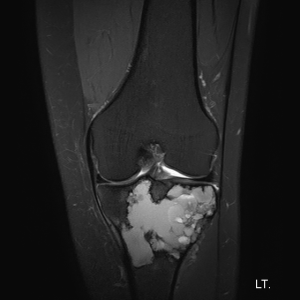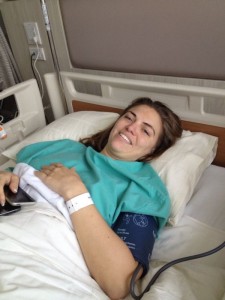It’s 6am, an ordinary Thursday morning, when the alarm sets off to get up. Another working day in the office is going to start. I didn’t sleep very well due to a pain in my left knee, and I notice a swelling. During the day the pain decreases but the swelling remains, hence I decide to make an appointment at the doctor for the following day.
On Friday, 18 April 2014 I walk into the hospital in Bangkok and the doctor examines my left knee. We both agree that it is most likely a meniscus, as my mother had several meniscus operations before and I knew the symptoms. In order to get more clarifications, I head immediately for an X-Ray.
Upon my return to the doctor’s office, I already notice from the look on his face that there is something wrong. He doesn’t tell me much but just that he suspects an “aneurismal bone cyst or a bone tumor”. Hence he sends me off immediately to get an MRI done. Fifteen minutes later, I lie in the MRI tube and catch myself praying “Please don’t let this be a tumor”.

MRI image: the tumor can be seen in white in my left tibia bone
You keep seeing movies where someone lies in a MRI tube; that anxious moment not knowing what will hit you next. I felt like being in a movie myself. I kept telling myself “This is just a bad dream”, but eventually you realize this is reality.
At the same time, a memory flashed through my mind: there were a few occasions where I felt the first symptoms in my knee. The first time around 2 months earlier when I was at a tradeshow in Berlin I felt a dragging pain in my knee, but I blamed it on the high heels I was wearing all day. The second time was when I went on a work trip to Nepal where I had a similar pain. And the third time was 5 days before my doctor’s appointment when I was putting furniture together being on my knees. Now suddenly things started to make sense!
The following day I receive a call from the doctor telling me that I most likely have a ‘Giant Cell Tumor’, an aggressive benign tumor which occurs in adults between 20 and 40 years. The thought of this being non-cancerous makes me calm down a bit and I manage to get through the next days.
In the meantime, I have started using crutches and I was not allowed to put pressure on my left leg, as a big part of my tibia bone was affected and weakened and there was a high risk of fracturing the bone.
A couple of days later, I got an appointment with an oncological orthopedic who advised me to do a surgery as soon as possible. Although the giant cell tumor is classified as benign, there have been cases where it metastasized into lungs or other bone parts. For that reason, I did a thorax (chest) CT-scan and a Scintigraphy, which is a nuclear scanning test to find abnormalities in other bone parts. Both scans showed I have no metastasis in either lungs or bones.
What is quite interesting: I have asked the doctors how long I may have this tumor in my bone and they replied around 5 months. Odd feeling to know that I had this little “piece of s*%@” was in my bone already during New Year’s Eve at the Full Moon Party in Koh Phangan, my birthday in January, and during my business trips in Europe and Nepal.
On 26 April 2014, I went for my surgery. Two orthopedic surgeons and a pathologist were in the Operations Room (OR).
What was missing for my actual diagnosis was a biopsy, which means a sample of my bone tissue had to be examined to determine if this is really a giant cell tumor or perhaps a malignant bone tumor. The deal was I get into OR, the surgeons remove a bit of bone tissue in order for the pathologist to conduct a biopsy, and if it results as benign they will continue with the surgery whilst if it results as malignant they close it up and the next step would be chemotherapy.
I remember very clearly that the OR was freezing cold whilst waiting for the surgeons to arrive, and my heart was beating out of my chest.
The next moment I remember is waking up in the anesthetic recovery room, and my first question was “Did you operate me?”. The nurse replied with a yes, and I fell asleep again.

A few hours after the surgery
The surgery was a success: the tumor was completely removed by scraping and scooping the bone tissue (also called curettage); a part of the gap was filled up with bone cement and some by bone grafting, a bone transplantation from the hip bone. The disadvantage is that the transplanted bone tissue is soft, and for 3 months I am not allowed to put pressure on my left leg in order to strengthen the tibia bone. After five days in hospital I was sent back home, and continued my recovery.
It was a relief to know that it was just a “benign tumor” and I was looking forward to recover fast. However, I also knew that the recurrence percentage after curettage and bone grafting lies at around 30% and hence, every 4 weeks I went for x-rays. At this point I didn’t know yet that it was the beginning of a very long and difficult journey.
So so brave Martina! Love you